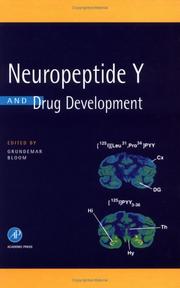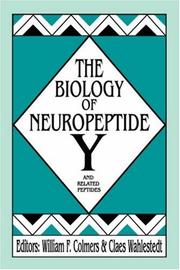| Listing 1 - 10 of 43 | << page >> |
Sort by
|

ISBN: 9780123049902 0123049903 9780080537450 0080537456 1281118931 9781281118936 9786611118938 Year: 1997 Publisher: San Diego : Academic Press,
Abstract | Keywords | Export | Availability | Bookmark
 Loading...
Loading...Choose an application
- Reference Manager
- EndNote
- RefWorks (Direct export to RefWorks)
Neuropeptide Y (NPY) is a ubiquitous and important messenger in the nervous system, with a wide range of physiological roles. It is involved in the body energy balance and is one of the most potent stimuli of food intake known. NPY also acts to regulate central and peripheral autonomic functions.This book, written by academic and industrial experts in the field, links the most recent basic experimental knowledge about NPY and its receptors with areas of clinical importance.This book will be of interest to those working in all areas of research affected by NPY, such as food intak

ISBN: 354040581X Year: 2004 Publisher: Berlin : Springer,
Abstract | Keywords | Export | Availability | Bookmark
 Loading...
Loading...Choose an application
- Reference Manager
- EndNote
- RefWorks (Direct export to RefWorks)
Neuropeptide Y --- Neuropeptide Y --- Derivatives --- Physiological effect. --- Physiological effect.
Book

Year: 2020 Publisher: Frontiers Media SA
Abstract | Keywords | Export | Availability | Bookmark
 Loading...
Loading...Choose an application
- Reference Manager
- EndNote
- RefWorks (Direct export to RefWorks)
This eBook is a collection of articles from a Frontiers Research Topic. Frontiers Research Topics are very popular trademarks of the Frontiers Journals Series: they are collections of at least ten articles, all centered on a particular subject. With their unique mix of varied contributions from Original Research to Review Articles, Frontiers Research Topics unify the most influential researchers, the latest key findings and historical advances in a hot research area! Find out more on how to host your own Frontiers Research Topic or contribute to one as an author by contacting the Frontiers Editorial Office: frontiersin.org/about/contact
hormone --- hypothalamus --- innervation --- neuropeptide --- receptor

ISBN: 9780123049902 0123049903 9780080537450 0080537456 1281118931 9781281118936 9786611118938 Year: 1997 Publisher: San Diego Academic Press
Abstract | Keywords | Export | Availability | Bookmark
 Loading...
Loading...Choose an application
- Reference Manager
- EndNote
- RefWorks (Direct export to RefWorks)
Neuropeptide Y (NPY) is a ubiquitous and important messenger in the nervous system, with a wide range of physiological roles. It is involved in the body energy balance and is one of the most potent stimuli of food intake known. NPY also acts to regulate central and peripheral autonomic functions.This book, written by academic and industrial experts in the field, links the most recent basic experimental knowledge about NPY and its receptors with areas of clinical importance.This book will be of interest to those working in all areas of research affected by NPY, such as food intak
Neuropeptide Y. --- Neuropeptides. --- Brain peptides --- Nerve tissue proteins --- Neurotransmitters --- Peptides --- Neuropeptide tyrosine --- NPY (Neuropeptide) --- Neuropeptides

ISBN: 0896032418 1475767250 9786610836222 1280836229 1592594654 Year: 1993 Volume: vol *1 Publisher: London Humana Press
Abstract | Keywords | Export | Availability | Bookmark
 Loading...
Loading...Choose an application
- Reference Manager
- EndNote
- RefWorks (Direct export to RefWorks)
Animal psychology and neurophysiology --- Animal biochemistry --- Brain peptides --- NPY (Neuropeptide) --- Neuropeptide Y --- Neuropeptide tyrosine --- Neuropeptiden --- Neuropeptides --- Peptiden [Neuro] --- Peptides [Neuro]
Book

Year: 2020 Publisher: Frontiers Media SA
Abstract | Keywords | Export | Availability | Bookmark
 Loading...
Loading...Choose an application
- Reference Manager
- EndNote
- RefWorks (Direct export to RefWorks)
This eBook is a collection of articles from a Frontiers Research Topic. Frontiers Research Topics are very popular trademarks of the Frontiers Journals Series: they are collections of at least ten articles, all centered on a particular subject. With their unique mix of varied contributions from Original Research to Review Articles, Frontiers Research Topics unify the most influential researchers, the latest key findings and historical advances in a hot research area! Find out more on how to host your own Frontiers Research Topic or contribute to one as an author by contacting the Frontiers Editorial Office: frontiersin.org/about/contact
Science: general issues --- Neurosciences --- hormone --- hypothalamus --- innervation --- neuropeptide --- receptor --- hormone --- hypothalamus --- innervation --- neuropeptide --- receptor

ISBN: 0897666542 Year: 1990 Publisher: New York NYAS
Abstract | Keywords | Export | Availability | Bookmark
 Loading...
Loading...Choose an application
- Reference Manager
- EndNote
- RefWorks (Direct export to RefWorks)
Neuropeptide Y --- Central Nervous System --- Peripheral Nerves --- CENTRAL NERVOUS SYSTEM, physiology --- NEUROPEPTIDE Y, metabolism --- PERIPHERAL NERVES, physiology --- Congresses. --- physiology --- congresses. --- metabolism --- Physiology --- Metabolism --- Central nervous system, physiology --- Central nervous system --- Neuropeptide y, metabolism --- Neuropeptide y --- Peripheral nerves, physiology --- Peripheral nerves
Book
Abstract | Keywords | Export | Availability | Bookmark
 Loading...
Loading...Choose an application
- Reference Manager
- EndNote
- RefWorks (Direct export to RefWorks)
Orexin/hypocretin neuropeptides, produced by a few thousand neurons in the lateral hypothalamus, are of critical importance for the control of vigilance and arousal of vertebrates, from fish to amphibians, birds and mammals. Two orexin peptides, called orexin-A and orexin-B, exist in mammals. They bind with different affinities to two distinct, widely distributed, excitatory G-protein- coupled receptors, orexin receptor type 1 and type 2 (OXR-1/2). The discovery of an OXR mutation causing canine narcolepsy, the narcolepsy-like phenotype of orexin peptide knockout mice, and the orexin neuron loss associated with human narcoleptic patients laid the foundation for the discovery of small molecule OXR antagonists as novel treatments for sleep disorders. Proof of concept studies from Glaxo Smith Kline, Actelion Pharmaceuticals Ltd. and Merck have now consistently demonstrated the efficacy of dual OXR antagonists (DORAs) in promoting sleep in rodents, dogs, non-human primates and humans. Some of these antagonists have completed late stage clinical testing in primary insomnia. Orexin drug discovery programs have also been initiated by other large pharmaceutical companies including Hoffmann La Roche, Novartis, Eli Lilly and Johnson & Johnson. Orexins are increasingly recognized for orchestrating the activity of the organism’s arousal system with appetite, reward and stress processing pathways. Therefore, in addition to models of insomnia, pharmacological effects of DORAs have begun to be investigated in rodent models of addiction, depression and anxiety. The first clinical trials in diabetic neuropathy, migraine and depression have been initiated with Merck’s MK-6096 (www.clinicaltrials.gov). Whereas the pharmacology of DORAs is established for their effects on wakefulness, pharmacological effects of selective OXR-1 or OXR-2 antagonists (SORAs) have remained less clear. From an evolutionary point of view, the OXR-2 was expressed first in most vertebrate lineages, whereas the OXR-1 is believed to result from a gene duplication event, when mammals emerged. Yet, both receptors do not have redundant function. Their brain expression pattern, their intracellular signaling, as well as their affinity for orexin-A and orexin-B differs. During the past decade most preclinical research on selective OXR-1 antagonism was performed with SB-334867. Only in recent years, other selective OXR-1 and OXR-2 antagonists with optimized selectivity profiles and pharmacokinetic properties have been discovered, and phenotypes of OXR-1 and OXR-2 knockout mice were described. The present Research Topic (referred to in the Editorial as “special topics issue”) comprises submissions of original research manuscripts as well as reviews, directed towards the neuropharmacology of OXR antagonists. The submissions are preclinical papers dealing with dual and/or selective OXR antagonists that shed light on the differential contribution of endogenous orexin signaling through both OXRs for cellular, physiological and behavioral processes. Some manuscripts also report on convergence or divergence of DORA vs. SORA effects with phenotypes expressed by OXR-1 or OXR-2 knockout animals. Ultimately these findings may help further define the potential of DORAs and SORAs in particular therapeutic areas in insomnia and beyond insomnia.
Neuroscience --- Addiction --- hypocretin --- Anxiety --- orexin --- orexin receptor antagonist --- Neuropeptide --- insomnia
Book

Year: 2020 Publisher: Frontiers Media SA
Abstract | Keywords | Export | Availability | Bookmark
 Loading...
Loading...Choose an application
- Reference Manager
- EndNote
- RefWorks (Direct export to RefWorks)
This eBook is a collection of articles from a Frontiers Research Topic. Frontiers Research Topics are very popular trademarks of the Frontiers Journals Series: they are collections of at least ten articles, all centered on a particular subject. With their unique mix of varied contributions from Original Research to Review Articles, Frontiers Research Topics unify the most influential researchers, the latest key findings and historical advances in a hot research area! Find out more on how to host your own Frontiers Research Topic or contribute to one as an author by contacting the Frontiers Editorial Office: frontiersin.org/about/contact
Science: general issues --- Neurosciences --- hormone --- hypothalamus --- innervation --- neuropeptide --- receptor
Book
Abstract | Keywords | Export | Availability | Bookmark
 Loading...
Loading...Choose an application
- Reference Manager
- EndNote
- RefWorks (Direct export to RefWorks)
Orexin/hypocretin neuropeptides, produced by a few thousand neurons in the lateral hypothalamus, are of critical importance for the control of vigilance and arousal of vertebrates, from fish to amphibians, birds and mammals. Two orexin peptides, called orexin-A and orexin-B, exist in mammals. They bind with different affinities to two distinct, widely distributed, excitatory G-protein- coupled receptors, orexin receptor type 1 and type 2 (OXR-1/2). The discovery of an OXR mutation causing canine narcolepsy, the narcolepsy-like phenotype of orexin peptide knockout mice, and the orexin neuron loss associated with human narcoleptic patients laid the foundation for the discovery of small molecule OXR antagonists as novel treatments for sleep disorders. Proof of concept studies from Glaxo Smith Kline, Actelion Pharmaceuticals Ltd. and Merck have now consistently demonstrated the efficacy of dual OXR antagonists (DORAs) in promoting sleep in rodents, dogs, non-human primates and humans. Some of these antagonists have completed late stage clinical testing in primary insomnia. Orexin drug discovery programs have also been initiated by other large pharmaceutical companies including Hoffmann La Roche, Novartis, Eli Lilly and Johnson & Johnson. Orexins are increasingly recognized for orchestrating the activity of the organism’s arousal system with appetite, reward and stress processing pathways. Therefore, in addition to models of insomnia, pharmacological effects of DORAs have begun to be investigated in rodent models of addiction, depression and anxiety. The first clinical trials in diabetic neuropathy, migraine and depression have been initiated with Merck’s MK-6096 (www.clinicaltrials.gov). Whereas the pharmacology of DORAs is established for their effects on wakefulness, pharmacological effects of selective OXR-1 or OXR-2 antagonists (SORAs) have remained less clear. From an evolutionary point of view, the OXR-2 was expressed first in most vertebrate lineages, whereas the OXR-1 is believed to result from a gene duplication event, when mammals emerged. Yet, both receptors do not have redundant function. Their brain expression pattern, their intracellular signaling, as well as their affinity for orexin-A and orexin-B differs. During the past decade most preclinical research on selective OXR-1 antagonism was performed with SB-334867. Only in recent years, other selective OXR-1 and OXR-2 antagonists with optimized selectivity profiles and pharmacokinetic properties have been discovered, and phenotypes of OXR-1 and OXR-2 knockout mice were described. The present Research Topic (referred to in the Editorial as “special topics issue”) comprises submissions of original research manuscripts as well as reviews, directed towards the neuropharmacology of OXR antagonists. The submissions are preclinical papers dealing with dual and/or selective OXR antagonists that shed light on the differential contribution of endogenous orexin signaling through both OXRs for cellular, physiological and behavioral processes. Some manuscripts also report on convergence or divergence of DORA vs. SORA effects with phenotypes expressed by OXR-1 or OXR-2 knockout animals. Ultimately these findings may help further define the potential of DORAs and SORAs in particular therapeutic areas in insomnia and beyond insomnia.
Neuroscience --- Addiction --- hypocretin --- Anxiety --- orexin --- orexin receptor antagonist --- Neuropeptide --- insomnia
| Listing 1 - 10 of 43 | << page >> |
Sort by
|

 Search
Search Feedback
Feedback About UniCat
About UniCat  Help
Help News
News